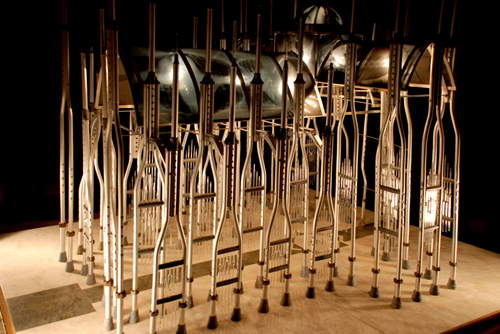
By Donald H. Harrison

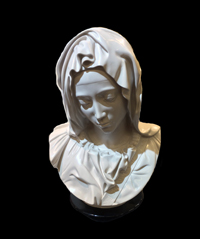
LA JOLLA, California – Curators Larry and Debby Kline have pulled together a multi-religious, multi-media exhibition in which religious symbols are conflated with symbols from other human arenas to produce an exhibition which may inspire some, anger others, but get everyone to think.
Titled “Seeing is Believing: A Reinvention of Articles of Faith,” the free exhibit at the Gotthelf Art Gallery at the Lawrence Family JCC opened on Wednesday, March 11, and will run through Wednesday, May 27.
Among the articles that may draw reverential visitors are casts in Carrara marble, authorized by the Vatican, of the heads of Mary and of Jesus from Michelangelo’s famous work ‘The Pieta,’ in which Mary grieves over the body of her son following his crucifixion.
The fact that the casts of the heads are shown separately from the main body of the Pieta is what particularly intrigued the Klines, who themselves are conceptual artists of note but who have stepped back into the curatorial role for this exhibit. Likening the marble heads to relics—or body parts—of the saints, which are kept and displayed in church-owned reliquaries, the Klines suggest that the heads lend themselves to the modern-day “cult of fame” and “become relics of human endeavor, creativity and the notoriety of the artist/ creator.”
While the real heads of the Pieta remain in place, these casts conceptually have been severed from the bodies of Jesus and Mary—a startling juxtaposition when one thinks of the beheading of captives by ISIS and the destruction of ancient religious sites.
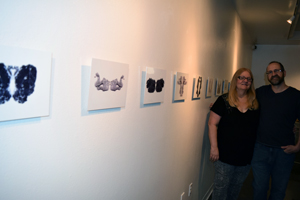
Paula Levine, a San Francisco artist, has 10 Rohrschach tests mounted in a series on one wall of the gallery. Texts from English translations of both Hebrew and Christian Scriptures were enlarged in the photocopying process and then assembled into blots. Viewers are encouraged to write down what the images remind them of , and also to identify themselves by age, religion and gender. The Klines suggested that this interactive exercise may offer a window into the perceptions of different groups.
One of the images reminded me of a cross that had been vertically sundered, or perhaps the heads of two horses. Debby Kline saw in that same image a suggestion of Tevye in Fiddler on the Roof.
Pleased by the different interpretations, Larry Kline said that the viewer’s own interpretation “is more important than the artist’s intent, which really is to give you a vehicle upon which you might base an interpretation.”
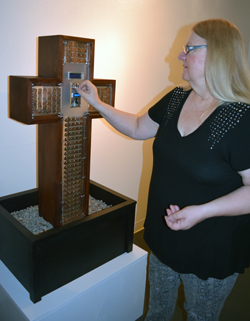
In another part of the gallery, a stout wooden cross, on closer examination, has been decorated with coins – and in fact can accept coins, slot machine style. Designed by Dave Ghilarducci, whose art machines typically deal with secular subjects, the cross invites one to play with it. With each coin put in, a new saying comes up in a panel. In my two attempts, I received the messages “Judge not lest you be judged” and “Prophet or profit?”
Larry Kline said that the idea is that in many organized religions, one invests money in search of redemption.
On another wall were works by brothers Einar and Jamex De La Torre, which because of their colors and complexity immediately reminded me of the “Tree of Life” sculptures one associates with Mexico’s Day of the Dead. The De La Torre brothers harmonize numerous media and their creations’ 3-D effects prompt visitors to look at “Flemish Tara” and “Smakelijk” from different angles.
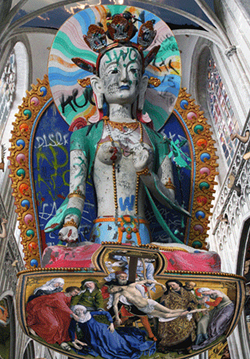
In the former creation, Tara (mother of all Buddhas) holds a seed pod, flower and bud, representing the past, present and future, and she is juxtaposed within the work with a miniature reproduction of Rogier van der Weyden’s painting of Jesus being removed from the cross. As crucifying Jesus was a defilement of his body, so too is the image of Tara defiled with graffiti.
Perhaps from a religious standpoint, the most hopeful pieces were those created by Cheryl Nickel, who uses tools of medicine and science to create religious symbols. Crutches and Xray film became part of the exterior of a large Cathedral, while other kinds of medical equipment were formed into a Mandala. Explain the Klines: “The Mandala is a radiating shape which tends to focus our attention inward, thus acting as an aide to meditation. “By incorporating the language of medicine in this work, it unites the healing power of science with the healing power of the mind.”
I asked the husband and wife curators what they hoped viewers would take away from the overall exhibit.
“One thing would be the commonalities of religion, that people of all faiths can find content in these pieces that are relevant,” said Larry. Debby said that if viewers find some of the objects irreverent, they might nevertheless take comfort in the fact that “questions are always being asked, and that means there is viability.”
*
Harrison is editor of San Diego Jewish World. Your comment may be sent to donald.harrison@sdjewishworld.com, or posted on this website, per the instructions below.
__________________________________________________________________
Care to comment? San Diego Jewish World is intended as a forum for the entire Jewish community, whatever your political leanings. Letters may be posted below provided they are civil, responsive to the article that prompted them, and signed with your first and last name, as well as with your city of residence. There is a limit of one letter per writer on any given day.
__________________________________________________________________